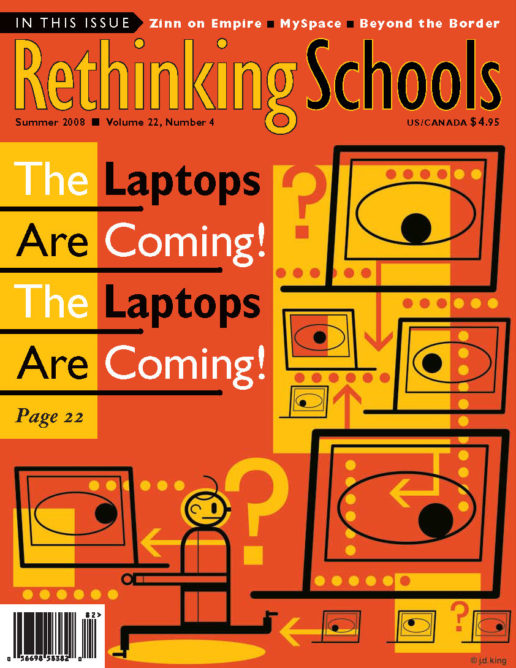Rethinking MySpace
Using social networking tools to connect with students
Illustrator: Brian Stauffer

The time stamp on my email program shows that the last MySpace message I received was Wednesday, 3:08 a.m., during my off-track vacation. Logging onto the site, I read the message that apparently could not wait to be sent until a more humane hour: “hey garcia, i was wondering if u could tell me what work im missing from both of ur classes so i can make it up during these days . . . and since i will be taking some interssesion classes i was wondering if u are ever going during vacation to school so i could give it to u.”
Preparing to reply to the email, I paused and wondered if being able to connect with students at all hours is really a part of a culturally relevant education experience.
I am in my third year at Manual Arts High School, a year-round school in South Central Los Angeles. Blocks away from the freeway and the University of Southern California, Manual Arts is in a low-income community; African Americans make up 20 percent of the student body, the remaining 80 percent Latino. In order to deal with overcrowding, the students are separated into three different tracks.
Although I’ve never been interested in the social and networking sites that now flood the internet, recent sites such as MySpace, Facebook, and Twitter have become too prominent in my students’ lives to ignore. As an educator constantly searching for ways to use popular culture in my classroom, I decided to make MySpace part of my teaching repertoire.
At the heart of MySpace is its ability to connect individuals into a greater social web. Initially, I had envisioned my page to be a place to post assignments, suggest discussion questions, and respond to student questions. Today, I’ve come to use the site for much more, whether communicating with students or tracking down those who may be habitually absent. Several former students have contacted me through the page (one inviting me to one of her concerts), one student had me walk her step-by-step through the online SAT registration-one MySpace message at a time-and I’ve even been invited to a quinceañera via MySpace.
More interestingly, students have contacted me as a way of circumscribing the bureaucracy of an overcrowded school. Several have used the site for me to help them inquire about fee waivers for college admissions tests and college applications. Though such information is available at our school’s college center, traveling to campus while our track is on vacation and talking one’s way past the security guard at the front door is not easy. While the site was supposed to be purely an outside resource, it’s become intertwined with the daily welfare of my students as they negotiate the school environment.
There are currently more than 100 million accounts registered at My-Space. Yet going to the main page is an underwhelming experience for the uninitiated user-I didn’t see the appeal of the myriad ads on the site for bands and films, or of the list with small photos of recently registered users. Only in accessing a member’s page did the site start to make sense.
Each member’s page can be customized. It has a space to upload pictures, allows visitors to leave comments, allows members to send messages, and provides a place to maintain a blog.
Most of my students spend time tweaking their individual MySpace pages, perhaps to play popular songs or customize their page’s appearance. Much like a pair of sneakers or the logo bejeweled on one’s belt, a student’s MySpace page is a reflection of their personality. Additionally, students’ status within the school community can be measured in terms of how many “friends” are connected to a given user; while my account struggled to attract a couple dozen initial friends, many of my students boast of hundreds of “friends.”
MySpace does not function in lieu of activities occurring at school. Being able to contact students in a manner that they are comfortable with helps encourage classroom participation. Two frequent users, for instance, are chronically absent at school and often ask for the assignments missed. Additionally, students who are often most reticent to speak in class are much more vocal through the online messaging format. Because of MySpace, difficult-to-reach students seek out advice, explain extenuating circumstances behind absences, and generally find a way to participate in the class curriculum-all outside of the school.
In creating the MySpace page for my classes, I found initially that students were hesitant to send “friend requests” allowing them to be connected to my site. The dilemma, apparently, was that I might pry into a student’s page, perhaps learning about activities that would not be endorsed in an English class. I’ve spoken with a colleague who also uses MySpace with her students. She occasionally peruses her students’ profiles to make sure they are staying out of trouble and are doing OK outside the classroom. While I understand her concerns, I started this site at the beginning of the year, when I was still gaining the trust of my students. Because of this, I told students that I would refrain from perusing their sites. I will send messages to students who I know are receptive to getting online messages but I do not look at, scrutinize, or judge the content on my students’ pages.
Additionally, as an English teacher, I have a feeling that some students are reluctant to use the messaging feature that is an integral part of MySpace. Some students resort to a minimalist form of letter writing when asking me a question: “Garcia, what is the homework?” or “How do I register for the SAT?” Some students adopt typical online conventions and jargon; their messages are rife with smiley symbols, non-Standard English spelling, and random words and letters capitalized. I have yet to interfere with students’ online writing style. As a developing teacher, I am unsure if students’ messaging vernacular is something I should be concerned about. After all, these are students writing outside of the classroom, which is never a bad thing. Further, in working with my seniors on résumés, cover letters, and interview techniques, I am confident that they are becoming proficient in using the most appropriate language for the setting. While spelling and grammar are issues that need to be honed and improved within the classroom, the word choice and format of students’ messages suggest that students are actively questioning the tone and audience to whom their messages are addressed.
The use of MySpace is not without controversy. The increased attention from shows like the “To Catch a Predator” series on NBC’s “Dateline”, along with general wariness about personal contact with students, often causes other teachers and friends to raise an eyebrow when we discuss the site. Although this site, to me, allows students to more easily contact me with class questions and to have a wealth of resources at their fingertips, others may see it as crossing a legitimate line between students and teachers. This is one reason why, from my syllabus to the first Back-to-School Night, I’ve made parents aware of the MySpace page and have invited them to contact me with any questions or concerns.
Though many of my students do not have computers or regular internet access at home, they have demonstrated an amazing resourcefulness in being able to regularly send messages and update their MySpace pages. These students know how to get around the school’s blocking program to access MySpace while at school. They also go to the local library, or to friends’ houses. In not expecting my students to have computers, my students are also not expected to have or excel in the same kinds of computer literacy skills taught in other schools. For me, this is a class issue; MySpace is a way to cross one of the many barriers between my students and an equal, fair education. Additionally, while I could simply create an official, school-associated website for my students, the use of MySpace is an endorsement of youth culture. My students can identify with and easily navigate the site. A school website, though it could convey the same information as the MySpace page, would likely receive less traffic due to the stifling formality associated with a school-sanctioned site.
Nonetheless, I find it hard to reconcile that I’m using the services of a Fox-owned company. (Rupert Murdoch’s News Corp. bought MySpace in 2005 for just over $500 million.) I struggle with the contradiction of wanting my students to develop a critical consciousness about wealth and power in the world-and to resist injustice- at the same time that I use the corporate-owned media tools that appeal to my school’s community.
While I regularly update homework and class assignments on my page, I have also begun placing information for upcoming activities that I think would interest my students. Unsure whether students were actually looking at the information on my site, I was pleasantly surprised when one of my students returned from our two-month break and said she went to hear Luis Rodriguez speak at a local book festival. Later, another student expressed interest in an event I had mentioned on the site, about the street artist Banksy. This was one of the first steps in using the page to extend my English class outside of the traditional classroom, and I continue to search for ways to use my MySpace site beyond a resource for homework and class work postings.
A culminating 12th-grade English project looms on the horizon as a means to integrate the site into my curriculum. While collaborating with the students’ government teacher to look at medical and social epidemics, we’ve asked students to create a positive “social epidemic” on our school’s campus. For most students, the assignment is daunting. Successfully completing it involves spreading an idea or belief to as many students as possible. I hope to sway students to use MySpace to spread messages and bulletins to fellow schoolmates-to take “ownership” of the mass media and to use MySpace to create a difference in the school atmosphere.
And that student who sent me a MySpace message at 3:08 a.m.? After lengthy message exchanges, I still felt unsure whether I was getting through to him, and I worried that MySpace might actually be hurting my ability to communicate with students. However, a week after I’d sent a final, lengthy message, I received a reply: “GARCIA!!! I am so sorry for not answering before, really i didnt want to leave u without an answer . . . but i couldnt send messages nor read them . . . i also wanted to leave u a message in ur voice mail but i lost ur #. . . yeah ur response makes sence to me . . . i get it . . . thank u very much . . . u rock. . . .”
Though the gratitude expressed in the student’s message is nice, it’s not what I found most fulfilling about the exchange. Three words validated all of the work I had put into the messaging system. “i get it” was one of those moments that, as a new teacher, I cling to and strive for. It was a moment of success and perhaps an ironic step towards equity, using the machinery of the rightwing media.

